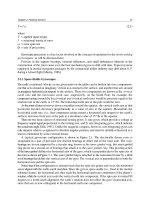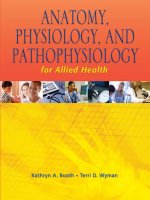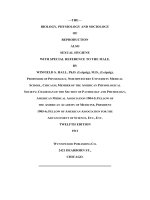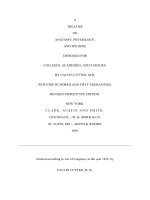Physiology and Hygiene for Secondary Schools pptx
Bạn đang xem bản rút gọn của tài liệu. Xem và tải ngay bản đầy đủ của tài liệu tại đây (1.43 MB, 515 trang )
Physiology and Hygiene for Secondary Schools
by Francis M. Walters, A.M.
Edition 1, (November 15, 2005)
D.C. Heath and Co. - Publishers
Original copyright 1909
"It is quite possible to give instruction in this subject in such a manner as not only to
confer knowledge which is useful in itself, but to serve the purpose of a training in
accurate observation, and in the methods of reasoning of physical science."—Huxley.
Preface
The aim in the preparation of this treatise on the human body has been, first, to set
forth in a teachable manner the actual science of physiology; and second, to present
the facts of hygiene largely as applied physiology. The view is held that "right living"
consists in the harmonious adjustment of one's habits to the nature and plan of the
body, and that the best preparation for such living is a correct understanding of the
physical self. It is further held that the emphasizing of physiology augments in no
small degree the educative value of the subject, greater opportunity being thus
afforded for exercise of the reasoning powers and for drill in the modus operandi of
natural forces. In the study of physiology the facts of anatomy have a place, but in an
elementary course these should be restricted to such as are necessary for revealing the
general structure of the body.
Although no effort has been spared to bring this work within the comprehension of the
pupil, its success in the classroom will depend largely upon the method of handling
the subject by the teacher. It is recommended, therefore, that the relations which the
different organs and processes sustain to each other, and to the body as a whole, be
given special prominence. The pupil should be impressed with the essential unity of
the body and should see in the diversity of its activities the serving of a common
purpose. In creating such an impression the introductory paragraphs at the beginning
of many of the chapters and the summaries throughout the book, as well as the general
arrangement of the subject-matter, will be found helpful.
Since the custom largely prevails of teaching physiology in advance of the sciences
upon which it rests—biology, physics, and chemistry—care should be exercised to
develop correct ideas of the principles and processes derived from these sciences. Too
much latitude has been taken in the past in the use of comparisons and illustrations
drawn from "everyday life." To teach that the body is a "house," "machine," or "city";
that the nerves carry "messages"; that the purpose of oxygen is to "burn up waste";
that breathing is to "purify the blood," etc., may give the pupil phrases which he can
readily repeat, but teaching of this kind does not give him correct ideas of his body.
The method of teaching, however, that uses the pupil's experience as a basis upon
which to build has a value not to be overlooked. The fact that such expressions as
those quoted above are so easily remembered proves the value of connecting new
knowledge with the pupil's experience. But the inadequacy of this experience must be
recognizedand taken into account. The concepts of the average pupil are entirely too
indefinite and limited to supply the necessary foundation for a science such as
physiology. Herein lies the great value of experiments and observations. They
supplement the pupil's experience, and increase both the number and definiteness of
his concepts. No degree of success can be attained if this phase of the study is omitted.
The best results in physiology teaching are of course attained where laboratory work
is carried on by the pupils, but where this cannot be arranged, class experiments and
observations must suffice. The Practical Work described at the close of most of the
chapters is mainly for class purposes. While these serve a necessary part in the
development of the subject, it is not essential that all of the experiments and
observations be made, the intention being to provide for some choice on the part of the
teacher. A note-book should be kept by the pupil.
To adapt the book to as wide a range of usefulness as possible, more subject-matter is
introduced than is usually included in an elementary course. Such portions, however,
as are unessential to a proper understanding of the body by the pupil are set in small
type, to be used at the discretion of the teacher.
The use of books of reference is earnestly recommended. For this purpose the usual
high school texts may be employed to good advantage. A few more advanced works
should, however, be frequently consulted. For this purpose Martin's Human
Body (Advanced Course), Rettger's Advanced Lessons in Physiology,
Thornton'sHuman Physiology, Huxley's Lessons in Elementary Physiology,
Howell's A Text-book of Physiology, Hough and Sedgwick's Hygiene and Sanitation,
and Pyle's Personal Hygiene will be found serviceable.
In the preparation of this work valuable assistance has been rendered by Dr. C.N.
McAllister, Department of Psychology, and by Professor B.M. Stigall, Department of
Biology, along the lines of their respective specialties, and in a more general way by
President W.J. Hawkins and others of the Warrensburg, Missouri, State Normal
School. Expert advice from Professor S.D. Magers, Instructor in Physiology and
Bacteriology, State Normal School, Ypsilanti, Michigan, has been especially helpful,
and many practical suggestions from the high school teachers of physiology of Kansas
City, Missouri, Professor C.H. Nowlin, Central High School, Dr. John W. Scott,
Westport High School, and Professor A.E. Shirling, Manual Training High School, all
of whom read both manuscript and proofs, have been incorporated. Considerable
material for the Practical Work, including the respiration experiment (page 101) and
the reaction time experiment (page 323), were contributed by Dr. Scott. Professor
Nowlin's suggestions on subject-matter and methods of presentation deserve special
mention. To these and many others the author makes grateful acknowledgment.
F.M.W.
MISSOURI STATE NORMAL SCHOOL,
SECOND DISTRICT, May 1, 1909.
Contents
Preface
Contents
PART I: THE VITAL PROCESSES
CHAPTER I - INTRODUCTION
CHAPTER II - GENERAL VIEW OF THE BODY
CHAPTER III - THE BODY ORGANIZATION
CHAPTER IV - THE BLOOD
CHAPTER V - THE CIRCULATION
CHAPTER VI - THE LYMPH AND ITS MOVEMENT THROUGH THE
BODY
CHAPTER VII - RESPIRATION
CHAPTER VIII - PASSAGE OF OXYGEN THROUGH THE BODY
CHAPTER IX - FOODS AND THE THEORY OF DIGESTION
CHAPTER X - ORGANS AND PROCESSES OF DIGESTION
CHAPTER XI - ABSORPTION, STORAGE, AND ASSIMILATION
CHAPTER XII - ENERGY SUPPLY OF THE BODY
CHAPTER XIII - GLANDS AND THE WORK OF EXCRETION
PART II: MOTION, COORDINATION, AND SENSATION
CHAPTER XIV - THE SKELETON
CHAPTER XV - THE MUSCULAR SYSTEM
CHAPTER XVI - THE SKIN
CHAPTER XVII - STRUCTURE OF THE NERVOUS SYSTEM
CHAPTER XVIII - PHYSIOLOGY OF THE NERVOUS SYSTEM
CHAPTER XIX - HYGIENE OF THE NERVOUS SYSTEM
CHAPTER XX - PRODUCTION OF SENSATIONS
CHAPTER XXI - THE LARYNX AND THE EAR
CHAPTER XXII - THE EYE
CHAPTER XXIII - THE GENERAL PROBLEM OF KEEPING WELL
APPENDIX
INDEX
[pg 001]
PHYSIOLOGY AND HYGIENE
PART I: THE VITAL PROCESSES
CHAPTER I - INTRODUCTION
To derive strength equal to the daily task; to experience the advantages of health and
avoid the pain, inconvenience, and danger of disease; to live out contentedly and
usefully the natural span of life: these are problems that concern all people. They are,
however, but different phases of one great problem—the problem of properly
managing or caring for the body. To supply knowledge necessary to the solution of
this problem is the chief reason why the body is studied in our public schools.
Divisions of the Subject.—The body is studied from three standpoints: structure, use
of parts, and care or management. This causes the main subject to be considered under
three heads, known as anatomy, physiology, and hygiene.
Anatomy treats of the construction of the body—the parts which compose it, what they
are like, and where located. Its main divisions are known as gross anatomy and
histology. Gross anatomy treats of the larger structures of the body,
while histology treats of the minute structures of which these are composed—parts too
small to be seen with the naked eye and which have to be studied with the aid of the
microscope.
[pg 002]Physiology treats of the function, or use, of the different parts of the body—
the work which the parts do and how they do it—and of their relations to one another
and to the body as a whole.
Hygiene treats of the proper care or management of the body. In a somewhat narrower
sense it treats of the "laws of health." Hygiene is said to be personal, when applied by
the individual to his own body; domestic, when applied to a small group of people, as
the family; and public, or general, when applied to the community as a whole or to the
race.
The General Aim of Hygiene.—There are many so-called laws of health, and for
these laws it is essential in the management of the body to find a common basis. This
basic law, suggested by the nature of the body and conditions that affect its well-
being, may be termed the Law of Harmony: The mode of living must harmonize with
the plan of the body. To live properly one must supply the conditions which his body,
on account of its nature and plan, requires. On the other hand, he must avoid those
things and conditions which are injurious, i.e., out of harmony with the body plan. To
secure these results, it is necessary to determine what is and what is not in harmony
with the plan of the body, and to find the means of applying this knowledge to the
everyday problems of living. Such is the general aim of hygiene. Stated in other
words: Hygiene has for its general aim the bringing about of an essential harmony
between the body and the things and conditions that affect it.
1
[pg 003]Relation of Anatomy and Physiology to the Study of Hygiene.—If the
chief object in studying the body is that of learning how to manage or care for it, and
hygiene supplies this information, why must we also study anatomy and physiology?
The answer to this question has already been in part suggested. In order to determine
what things and conditions are in harmony with the plan of the body, we must know
what that plan is. This knowledge is obtained through a study of anatomy and
physiology. The knowledge gained through these subjects also renders the study of
hygiene more interesting and valuable. One is enabled to see why and how obedience
to hygienic laws benefits, and disobedience to them injures, the body. This causes the
teachings of hygiene to be taken more seriously and renders them more practical. In
short, anatomy and physiology supply a necessary basis for the study of hygiene.
Advantages of Properly Managing the Body.—One result following the
mismanagement of the body is loss of health. But attending the loss of health are other
results which are equally serious and far-reaching. Without good health, people fail to
accomplish their aims and ambitions in life; they miss the joy of living; they lose their
ability to work and become burdens on their friends or society. The proper
management of the body means health, and it also means the capacity for work and for
enjoyment. Not only should one seek to preserve his health from day to day, but he
should so manage his body as to use his powers to the best advantage and prolong as
far as possible the period during which he may be a capable and useful citizen.
[pg 004]
CHAPTER II - GENERAL VIEW OF THE BODY
External Divisions.—Examined from the outside, the body presents certain parts, or
divisions, familiar to all. The main, or central, portion is known as the trunk, and to
this are attached the head, the upper extremities, and thelower extremities. These in
turn present smaller divisions which are also familiar. The upper part of the trunk is
known as the thorax, or chest, and the lower part as the abdomen. The portions of the
trunk to which the arms are attached are the shoulders, and those to which the legs are
joined are the hips, while the central rear portion between the neck and the hips is
the back. The fingers, the hand, the wrist, the forearm, the elbow, and the upper arm
are the main divisions of each of the upper extremities. The toes, the foot, the ankle,
the lower leg, the knee, and the thigh are the chief divisions of each of the lower
extremities. The head, which is joined to the trunk by the neck, has such interesting
parts as the eyes, the ears, the nose, the jaws, the cheeks, and the mouth. The entire
body is inclosed in a double covering, called the skin, which protects it in various
ways.
The Tissues.—After examining the external features of the body, we naturally inquire
about its internal structures. These are not so easily investigated, and much which is of
interest to advanced students must be omitted from an elementary course. We may,
however, as a first step in this study, determine what kinds of materials enter into [pg
005]the construction of the body. For this purpose the body of some small animal
should be dissected and studied. (See observation at close of chapter.) The different
materials found by such a dissection correspond closely to the substances,
called tissues, which make up the human body. The main tissues of the body, as
ordinarily named, are the muscular tissue, the osseous tissue, the connective tissue,
the nervous tissue, the adipose tissue, thecartilaginous tissue, and
the epithelial and glandular tissue. Most of these present different varieties, making
all together some fifteen different kinds of tissues that enter into the construction of
the body.
2
General Purposes of the Tissues.—The tissues, first of all, form the body. As a
house is constructed of wood, stone, plaster, iron, and other building materials, so is
the body made up of its various tissues. For this reason the tissues have been called
the building materials of the body.
In addition to forming the body, the tissues supply the means through which its work
is carried on. They are thus theworking materials of the body. In serving this purpose
the tissues play an active rôle. All of them must perform the activities of growth and
repair, and certain ones (the so-called active tissues) must do work which benefits the
body as a whole.
Purposes of the Different Tissues.—In the construction of the body and also in the
work which it carries on, the different tissues are made to serve different purposes.
The osseous tissue is the chief substance in the bony framework, or skeleton, while the
muscular tissue produces the different movements of the body. The connective[pg
006]tissue, which is everywhere abundant, serves the general purpose of connecting
the different parts together. Cartilaginous tissue forms smooth coverings over the ends
of the bones and, in addition to this, supplies the necessary stiffness in organs like the
larynx and the ear. The nervous tissue controls the body and brings it into proper
relations with its surroundings, while the epithelial tissue (found upon the body
surfaces and in the glands) supplies it with protective coverings and secretes liquids.
The adipose tissue (fat) prevents the too rapid escape of heat from the body, supplies it
with nourishment in time of need, and forms soft pads for delicate organs like the
eyeball.
Properties of the Tissues.—If we inquire how the tissues are able to serve such
widely different purposes, we find this answer. The tissues differ from one another
both in composition and in structure and, on this account, differ in their
properties.
3
Their different properties enable them to serve different purposes in the
body. Somewhat as glass is adapted by its transparency, hardness, and toughness to
the use made of it in windows, the special properties of the tissues adapt them to the
kinds of service which they perform. Properties that adapt tissues to their work in the
body are called essential properties. The most important of these essential properties
are as follows:
1. Of osseous tissue, hardness, stiffness, and toughness. 2. Of muscular tissue,
contractility and irritability. 3. Of nervous tissue, irritability and conductivity. 4. Of
cartilaginous tissue, stiffness and elasticity. 5. Of connective tissue, toughness and
pliability. 6. Of epithelial tissue, ability to resist the action of external forces and
power to secrete.
[pg 007]
Fig. 1—Hand and forearm, showing the grouping of muscular and connective tissues
in the organ for grasping.
Tissue Groups.—In the construction of the body the tissues are grouped together to
form its various divisions or parts. A group of tissues which serves some special
purpose is known as an organ. The hand, for example, is an organ for grasping (Fig.
1). While the different organs of the body do not always contain the same tissues, and
never contain them in the same proportions, they do contain such tissues as their work
requires and these have a special arrangement—one adapted to the work which the
organs perform.
In addition to forming the organs, the tissues are also grouped in such a manner as to
provide supports for organs and to form cavities in which organs are placed. The
various cavities of the body are of particular interest and importance. The three largest
ones are the cranial cavity, containing the brain; the thoracic cavity, containing the
heart and the lungs; and the abdominal cavity, containing the stomach, the liver, the
intestines, and other important organs (Fig. 2). Smaller cavities serving different
purposes are also found.
[pg 008]
Fig. 2—Diagram of a lengthwise section of the body to show its large cavities and the
organs which they contain.
Organs and Systems.—The work of the body is carried on by its various organs.
Many, in fact the majority, of these organs serve more than one purpose. The
tongue[pg 009] is used in talking, in masticating the food, and in swallowing. The
nose serves at least three distinct purposes. The mouth, the arms, the hands, the feet,
the legs, the liver, the lungs, and the stomach are also organs that serve more than one
purpose. This introduces the principle of economy into the construction of the body
and diminishes the number of organs that would otherwise be required.
The various organs also combine with one another in carrying on the work of the
body. An illustration of this is seen in the digestion of the food—a process which
requires the combined action of the mouth, stomach, liver, intestines, and other
organs. A number of organs working together for the same purpose form a system.
The chief systems of the body are the digestive system, the circulatory system, the
respiratory system, the muscular system, and the nervous system.
The Organ and its Work.—A most interesting question relating to the work of the
organ is this: Does the organ work for its own benefit or for the benefit of the body as
a whole? Does the hand, for example, grasp for itself or in order that the entire body
may come into possession? Only slight study is sufficient to reveal the fact that each
organ performs a work which benefits the body as a whole. In other words, just as the
organ itself is a part of the body, the work which it does is a part of the necessary
work which the body has to do.
But in working for the general good, or for the body as a whole, each organ becomes a
sharer in the benefits of the work done by every other organ. While the hand receives
only a little of the nourishment contained in the food which it places in the mouth or
of the heat from, fuel which it places on the fire, it is aided and supported by the work
of all the other organs of the body—eyes, [pg 010]feet, brain, heart, etc. The hand
does not and cannot work independently of the other organs. It is one of the partners
in a very close combination where, by doing a particular work, it, shares in the profits
of all. What is true of the hand is true of every other organ of the body.
An Organization.—The relations which the different organs sustain to each other and
to the body as a whole suggest the possibility of classifying the body as an
organization. This term is broadly applied to a variety of combinations. An
organization is properly defined as any group of individuals which, in working
together for a common purpose, practices the division of labor. This definition will be
better understood by considering a few familiar examples.
A baseball team is an organization. The team is made up of individual players. These
work together for the common purpose of winning games. They practice the division
of labor in that the different players do different things—one catching, another
pitching, and so on. A manufacturing establishment which employs several workmen
may also be an organization. The article manufactured provides the common purpose
toward which all strive; and, in the assignment of different kinds of work to the
individual workmen, the principle of division of labor is carried out. For the same
reason a school, a railway system, an army, and a political party are organizations.
An organization of a lower order of individuals than these human organizations is to
be found in a hive of bees. This is made up of the individual bees, and these, in
carrying on the general work of the hive, are known to practice the division of labor.
Is the Body an Organization?—If the body is an organization, it must fulfill the
conditions of the definition. It[pg 011] must be made up of separate or individual
parts. These must work together for the same general purpose, and, in the
accomplishment of this purpose, must practice the division of labor. That the body
practices the division of labor is seen in the related work of the different organs. That
it is made up of minute, but individual, parts will be shown in the chapter following.
That it carries on a general work which is accomplished through the combined action
of its individual parts is revealed through an extended study of its various
activities. The body is an organization.Moreover, it is one of the most complex and, at
the same time, most perfect of the organizations of which we have knowledge.
Summary.—Viewed from the outside, the body is seen to be made up of divisions
which are more or less familiar. Viewed internally, it is found to consist of different
kinds of materials, called tissues. The tissues are adapted, by their properties, to
different purposes both in the construction of the body and in carrying on its work.
The working parts of the body are called organs and these in their work combine to
form systems. The entire body, on account of the method of its construction and the
character of its work, may be classed as an organization.
Exercises.—1. Name and locate the chief external divisions of the body.
2. What tissues may be found by dissecting the leg of a chicken?
3. Name the most important properties and the most important uses of muscular tissue,
osseous tissue, and connective tissue.
4. Define an organ. Define a system. Name examples of each.
5. Name the chief cavities of the body and the organs which they contain.
6. What tissues are present in the hand? How does each of these aid in the work of the
hand?
[pg 012]7. Define an organization. Show that a railway system, an army, and a school
are organizations.
8. What is meant by the phrase "division of labor"? In what manner is the division of
labor practiced in a shoe or watch factory? What are the advantages?
9. What are the proofs that the body is an organization?
PRACTICAL WORK
Observation on the Tissues.—Examine with care the structures in the entire leg of a
chicken, squirrel, rabbit, or other small animal used for food. Observe, first of all, the
external covering, consisting of cuticle and hair, claws, scales, or feathers, according
to the specimen. These are similar in structure, and they form the epidermis, which is
one kind of epithelial tissue. With a sharp knife lay open the skin and observe that it is
attached to the parts underneath by thin, but tough, threads and sheaths. These
represent a variety of connective tissue. The reddish material which forms the greater
portion of the specimen is a variety of muscular tissue, and its divisions are called
muscles. With a blunt instrument, separate the muscles, by tearing apart the
connective tissue binding them together, and find the glistening white strips of
connective tissue (tendons) which attach them to the bones. Find near the central part
of the leg a soft, white cord (a nerve) which represents one variety of nervous tissue.
The bones, which may now be examined, form the osseous tissue. At the ends of the
bones will be found a layer of smooth, white material which represents one kind
of cartilaginous tissue. The adipose, or fatty, tissue, which is found under the skin and
between the other tissues, is easily recognized.
Relation of the Tissues to the Organs.—Observe in the specimen just studied the
relation of the different tissues to the organ as a whole (regarding the leg as an
organ), i.e., show how each of the tissues aids in the work which the organ
accomplishes. Show in particular how the muscles supply the foot with motion, by
tracing out the tendons that connect them with the toes. Pull on the different tendons,
noting the effect upon the different parts of the foot.
[pg 013]
CHAPTER III - THE BODY ORGANIZATION
What is the nature of the body organization? What are the individual parts, or units,
that make it up? What general work do these carry on and upon what basis do they
practice the division of labor? The answers to these questions will suggest the main
problems in the study of the body.
Fig. 3—Diagram showing the relation of the cells and the intercellular
material. C. Cells. I. Intercellular material.
Complex Nature of the Tissues.—To the unaided eye the tissues have the
appearance of simple structures. The microscope, however, shows just the reverse to
be true. When any one of the tissues is suitably prepared and carefully examined with
this instrument, at least two classes of materials can be made out. One of these
consists of minute particles, called cells; the other is a substance lying between the
cells, known as the intercellular material(Fig. 3). The cells and the intercellular
material, though varying in their relative proportions, are present in all the tissues.
The Body a Cell Group.—The biologist has found that the bodies of all living things,
plants as well as animals, consist either of single cells or of groups of cells. The single
cells live independently of one another, but the cells that form groups are attached to,
and are more or less dependent upon, one another. In the first condition are [pg
014]found the very lowest forms of life. In the second, life reaches its greatest
development. The body of man, which represents the highest type of life, is
recognized as a group of cells. In this group each cell is usually separate and distinct
from the others, but is attached to them, and is held in place by the intercellular
material.
Protoplasm, the Cell Substance.—The cell is properly regarded as an organized bit
of a peculiar material, calledprotoplasm. This is a semi-liquid and somewhat granular
substance which resembles in appearance the white of a raw egg. Its true nature and
composition are unknown, because any attempt to analyze it kills it, and dead
protoplasm is essentially different from living protoplasm. It is known, however, to be
a highly complex substance and to undergo chemical change readily. It appears to be
the only kind of matter with which life is ever associated, and for this reason
protoplasm is called the physical basis of life. Its organization into separate bits, or
cells, is necessary to the life activities that take place within it.
Structure of the Cell.—Though all portions of the cell are formed from the
protoplasm, this essential substance differs both in structure and in function at
different places in the cell. For this reason the cell is looked upon as a complex body
having several distinct parts. At or near the center is a clear, rounded body, called
the nucleus. This plays some part in the nourishment of the cell and also in the
formation of new cells. If it be absent, as is sometimes the case, the cell is short-lived
and unable to reproduce itself. The variety of protoplasm contained in the nucleus is
called the nucleoplasm.
Fig. 4—Diagram of a typical cell (after Wilson). 1. Main body. 2. Nucleus. 3.
Attraction sphere. 4. Food particles and waste. 5. Cell-wall. 6. Masses of active
material found in certain cells, called plastids.
Surrounding the nucleus is the main body of the cell, sometimes referred to as the
"protoplasm." Since the[pg 015]protoplasm forms all parts of the cell, this substance is
more properly called the cytoplasm, or cell plasm. Surrounding and inclosing the
cytoplasm, in many cells, is a thin outer layer, or membrane, which affords more or
less protection to the contents of the cell. This is usually referred to as the cell-wall. A
fourth part of the cell is also described, being called the attraction sphere. This is a
small body lying near the nucleus and coöperating with that body in the formation of
new cells. Food particles, wastes, and other substances may also be present in the
cytoplasm. The parts of a typical cell are shown in Fig. 4.
Importance of the Cells.—The cells must be regarded as the living, working parts of
the body. They are the active agents in all of the tissues, enabling them to serve their
various purposes. Working through the tissues, they build up the body and carry on its
different activities. They are recognized on this account as the units of structure and of
function, and are the "individuals" in the body organization. Among the most
important and interesting of the activities of the cells are those by which they build up
the body, or cause it to grow.
[pg 016]How the Cells enable the Body to Grow.—Every cell is able to take new
material into itself and to add this to the protoplasm. This tends to increase the amount
of the protoplasm, thereby causing the cells to increase in size. A general increase in
the size of the cells has the effect of increasing the size of the entire body, and this is
one way by which they cause it to grow. There is, however, a fixed limit, varying with
different cells, to the size which they attain, and this is quite low. (The largest cells are
scarcely visible to the naked eye.) Any marked increase in the size of the body must,
therefore, be brought about by other means. Such a means is found in the formation of
new cells, or cell reproduction. The new cells are always formed by and from the old
cells, the essential process being known as cell-division.
Fig. 5—Steps in cell-division (after Wilson). Note that the process begins with the
division of the attraction sphere, then involves the nucleus, and finally separates the
main body.
Cell-Division.—By dividing, a single cell will, on attaining its growth, separate into
two or more new cells. The process is quite complex and is imperfectly understood. It
is known, however, that the act of separation is preceded by a series of changes in
which the attraction sphere[pg 017] and the nucleus actively participate, and that, as a
result of these changes, the contents of the old cell are rearranged to form the new
cells. Some of the different stages in the process, as they have been studied under the
microscope, are indicated in Fig. 5.
Gradually, through the formation of new cells and by the growth of these cells after
they have been formed, the body attains its full size. When growth is complete, cell
reproduction is supposed to cease except where the tissues are injured, as in the
breaking of a bone, or where cells, like those at the surface of the skin, are subject to
wear. Then new material continues to be added to the protoplasm throughout life, but
in amount only sufficient to replace that lost from the protoplasm as waste.
Fig. 6—A tumbler partly filled with marbles covered with water, suggesting the
relations of the cells to the lymph.
Cell Surroundings.—All cells are said to be aquatic. This means simply that they
require water for carrying on their various activities. The cells, in order to live, must
take in and give out materials, and water is necessary to both processes. It is also an
essential part of the protoplasm. Deprived of water, cells become inactive and usually
die. Aquatic surroundings are provided for the cells of the body through a liquid
known as the lymph, which is distributed throughout the intercellular material (Fig. 6).
This consists of water containing oxygen and food substances in solution. Besides
supplying these to the cells, the lymph also receives their wastes. Through the lymph
the necessary conditions for cell life are provided in the body.
The General Work of Cells.—In handling the materials[pg 018] derived from the
lymph, the cells carry on three well-defined processes, known as absorption,
assimilation, and excretion.
Absorption is the process of taking water, food, and oxygen into the cells.
Assimilation is a complex process which results in the addition of the absorbed
materials to the protoplasm. Through assimilation the protoplasm is built up or
renewed.
Excretion is the throwing off of such waste materials as have been formed in the cells.
These are passed into the lymph and thence to the surface of the body.
Absorption, assimilation, excretion, and also reproduction are performed by all classes
of cells. They are, on this account, referred to as the general work of cells.
The Special Work of Cells.—In addition to the general work which all cells do in
common, each class of cells in the body is able to do some particular kind of work—a
work which the others cannot do or which they can do only to a limited extent. This is
spoken of as the special work of cells. Examples of the special work of cells are found
in the production of motion by muscle cells and in the secretion of liquids by gland
cells. It may be noted that while the general work of cells benefits them individually,
their special work benefits the body as a whole. Another example of the special work
of cells is found in the
Fig. 7—Cartilage cells, surrounded by the intercellular material which they have
deposited.
Production of the Intercellular Material.—Though most of the cells of the body
deposit to a slight extent this material, the greater part of it is produced by a single
class of cells found in bone, cartilage, and connective tissue. Cartilage, bone, and
connective tissue differ greatly from the other tissues in the amount of intercellular
material which they contain, the difference being due to these cells.[pg 019] In the
connective tissue they deposit the fibrous material so important in holding the
different parts of the body together. In the cartilage they produce the gristly substance
which forms by far its larger portion (Fig. 7). In the bones they deposit a material
similar to that in the cartilage, except that with it is mixed a mineral substance which
gives the bones their hardness and stiffness.
4
The intercellular material, in addition to
connecting the cells, supplies to certain tissues important properties, such as the
elasticity of cartilage and the stiffness of the bones.
Nature of the Body Organization.—The division of labor carried on by the different
organs, as shown in the preceding chapter, is in reality carried on by the cells that
form the organs. To see that this is true we have only to observe the relation of cells to
tissues and of tissues to organs. The cells form the tissues and the tissues form the
organs. This arrangement enables the special work of different kinds of cells to be
combined in the work of the organ as a whole. This is seen in the hand which, in
grasping, uses motion supplied by the muscle cells, a controlling influence supplied
by the nerve cells, a framework supplied by the bone cells, and so on. The cells supply
the basis for the body organization and, properly speaking, the body is an
organization of cells
5
(Recall the definition[pg 020] of an organization, page 10.) In
this organization there are to be observed:
1. A definite arrangement of the cells to form the tissues. A tissue is a group of like
cells.
2. A definite arrangement of the tissues in the organ. Each organ contains the tissues
needed for its work.
3. In several instances there is a definite arrangement of organs to form systems.
4. The body as a whole is made up of organs and systems, together with the structures
necessary for their support and protection.
There now remains a further question for consideration. What is the one supreme end,
or purpose, toward which all the activities of the body organization are directed? This
purpose will naturally have some relation to the maintenance, or preservation, of the
cell group which we call the body.
The Maintenance of Life.—The preservation of any cell group in its natural
condition, whether it be plant or animal, is accomplished through keeping it alive. If
life ceases, the group quickly disintegrates and its elements become scattered, a fact
which is verified through everyday observation. Though the nature of life is unknown,
it may be looked upon as the organizer and preserver of the protoplasm. But in
preserving the protoplasm it also preserves the entire cell group, or body. Life is thus
the most essential condition of the body. With life all portions of the body are
concerned, and toward its maintenance all the activities of the body organization are
directed.
The Nutrient Fluid in its Relations to the Cells.—The maintenance of life within
the cells requires, as we have seen, that they be supplied with water, food, and oxygen,
and that they be relieved of such wastes as they form.[pg 021] This double purpose is
accomplished through the agency of an internal nutrient fluid, a portion of which has
already been referred to as the lymph. Not only does this fluid supply the means for
keeping the cells alive, but, through the cells, it is also the means of preserving the life
of the body as a whole.
The cells, however, rapidly exhaust the nutrient fluid. They take from it food and
oxygen and they put into it their wastes. To prevent its becoming unfit for supplying
their needs, food and oxygen must be continually added to this fluid, and waste
materials must be continually removed. This is not an easy task. As a matter of fact,
the preparation, distribution, and purification of the nutrient fluid requires the direct or
indirect aid of practically all parts of the body. It supplies for this reason a broad basis
for the division of labor on the part of the cells.
Relation of the Body to its Environment.—While life is directly dependent upon the
internal nutrient fluid, it is indirectly dependent upon the physical surroundings of the
body. Herein lies the need of the external organs—the feet and legs for moving about,
the hands for handling things, the eyes for directing movements, etc. That the great
needs of the body are supplied from its surroundings are facts of common experience.
Food, shelter, air, clothing, water, and the means of protection are external to the body
and form a part of its environment. In making the things about him contribute to his
needs, man encounters a problem which taxes all his powers. Only by toil and
hardship, "by the sweat of his brow," has he been able to wrest from his surroundings
the means of his sustenance.
The Main Physiological Problems.—The study of the body is thus seen to resolve
itself naturally into the consideration of two main problems:
[pg 022]1. That of maintaining in the body a nutrient fluid for the cells.
2. That of bringing the body into such relations with its surroundings as will enable it
to secure materials for the nutrient fluid and satisfy its other needs.
The first problem is internal and includes the so-called vital processes, known as
digestion, circulation, respiration, and excretion. The second problem is external, as it
were, and includes the work of the external organs—the organs of motion and of
locomotion and the organs of special sense. These problems are closely related, since
they are the two divisions of the one problem of maintaining life. Neither can be
considered independently of the other. In the chapter following is taken up the first of
these problems.
Summary.—The individual parts, or units, that form the body organization are known
as cells. These consist of minute but definitely arranged portions of protoplasm and
are held together by the intercellular material. They build up the body and carry on its
different activities. The tissues are groups of like cells. By certain general activities
the cells maintain their existence in the tissues and by the exercise of certain special
activities they adapt the tissues to their purposes in the body. The body, as a cell









